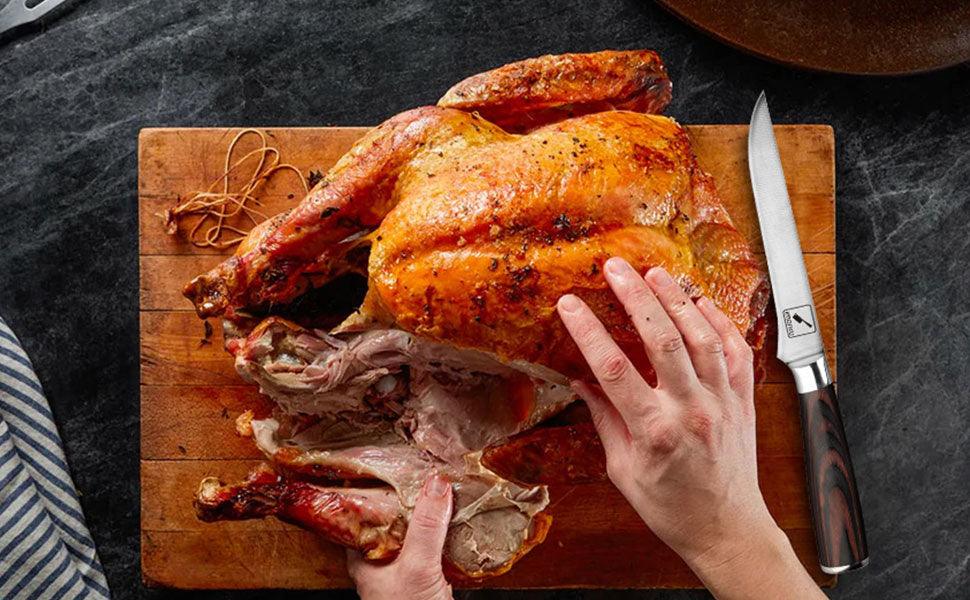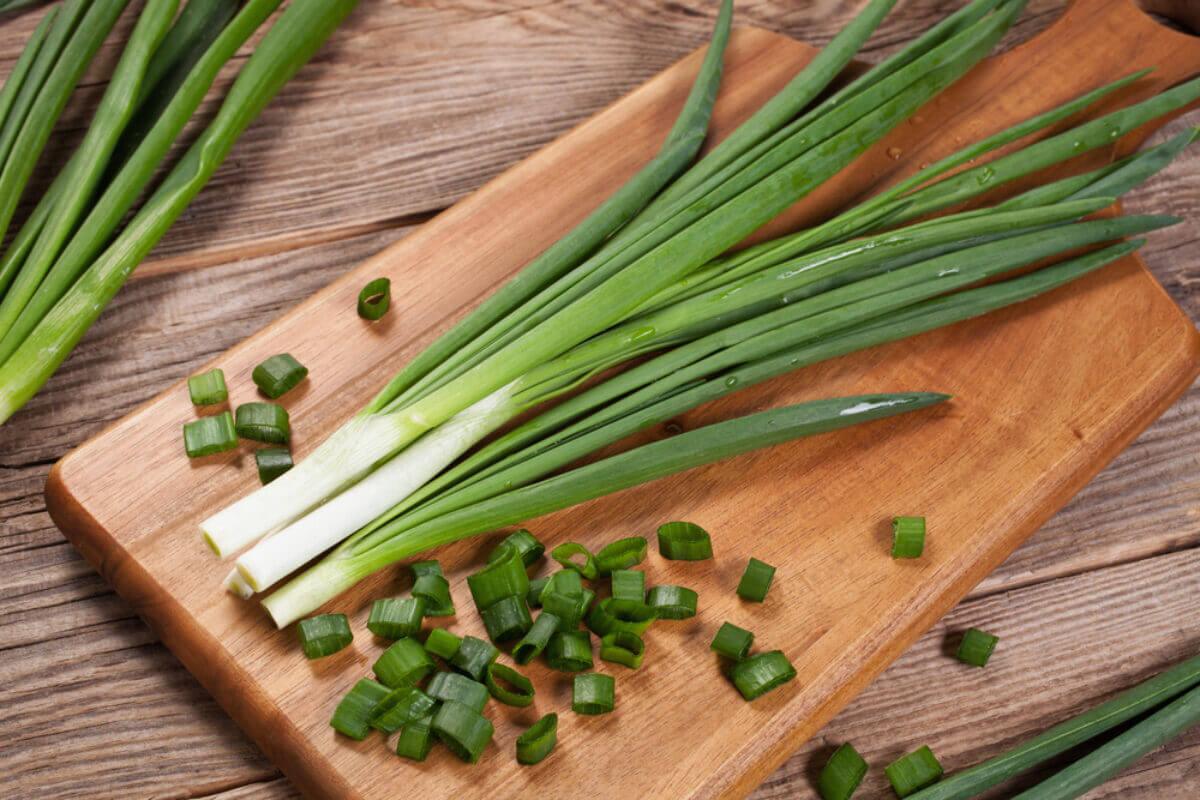TABLE OF CONTENTS
Whether you want to revolutionize your daily meal prep or chop ingredients faster, a quality knife will make the task easier. Unfortunately, most of us use a knife without learning about the different parts.
This matters in a professional kitchen. So before you add a knife to your arsenal, you should ensure it’s sharp, dependable, and comfortable to use. In this post, we’ll discuss the anatomy of a chef knife and how to handle it like a pro.

Overview
A chef’s knife is designed to feel like an extension of your hand. It helps to dice vegetables and chop fruits. Some professional chefs use it to cut poultry, fish, and meat. And given the amount of time the knife spends on your hand, you should make sure you have a quality one.
When your knife is comfortable and razor-sharp, you get more control when chopping ingredients. A lot of people will recommend that you buy a knife you can afford, but there’s more to that.
Read on to learn more.

The Blade
The blade ensures a precise cut of ingredients to desired sizes. A quality chef knife features a stainless steel blade that won’t discolor or rust. It’s also formulated to increase stain and shock resistance. Some are hardened to take any beating you throw at them.
Japanese stainless steel chef’s knives have high carbon content and hold an edge very well. Some go through the heat-treating process to make them achieve the desired hardness. Others undergo annealing and tempering to make them more durable.
Blades made of ordinary carbon are relatively easier to sharpen but go dull easily. Since the material defines the characteristics of the knife, you should choose stainless steel blades. Some have oval depressions (Santoku knife) to prevent food from sticking to the blade. Of course, the strength varies according to purpose.
Even though the blade features a single piece of steel, it’s also divided into other parts. For instance, the upper part of the blade is called the spine. This part is thick thus suitable for breaking harder materials. Some knives have a curved spine while others are straight- each has a specific use.
Another important part of the blade is the heel. It’s close to the bolster and can be either be spear point or smooth. Then, we have the actual cutting edge. It can be serrated or straight, depending on the chef’s knife you choose. Finally, we have the tip which comes in handy when cutting delicate products.

Blade Size
The blade size is 8-12” to help you make a longer stroke when slicing. For most chefs, the 8-inch size is manageable.
Blade Style
Those that have a curved section are good for chopping or rocking. The blades can also be stamped or forged – both styles can produce high-quality knives. Generally, chef’s knives feature three blade styles:
Japanese style
This is a common style in many chef knives. They are coveted for their intricate designs and are suitable for those who care about performance. Some price them for their amazing edge retention, ergonomics, maneuverability, precision, and durability. A Japanese-style chef knife creates tiny pockets of air between the knife and the products you cut. This minimizes sticking and friction.
German-style
The blade tends to be curved towards the tip. This makes the knife the perfect tool for chopping, as well as for chefs who prefer rocking slicing motion.
French style
It features a triangular shape, which is suitable for chefs who prefer the slicing motion. You’ll have fun drawing the blade towards you.
Western-style
This is a double-edged blade designed to make cutting and maintenance a breeze.

The Handle
Every time you chop or cut, you get into contact with the handle. It shouldn’t feel slippery or give excessive grip. The last thing you want is a handle that feels uncomfortable.
The handles of a chef knife are made of wood, resin, or composite materials. When choosing the knife, you should choose a material that balances well in your hand. The handle starts at the spine to ensure you maintain a safe grip. But again, it all boils down to individual taste and preference.
Handle Materials
Wood is non-porous and can cause food-related illness. For example, bacteria can grow in the tiny cracks where the wood joins with rivets. Not to mention, the handle doesn’t go well in the dishwasher.
Composite handles are durable, light, and impervious to moisture. They recently rose to popularity and became a common material for handles. At the very basic, a composite material resembles the traditional wood and deals with any sanitation concerns associated with wooden handles.
The wood resin can fit the bill for those looking for a modern touch. It provides superior durability and brings the right balance to the hand.
Handle Styles
Some chef knives feature the western style. The handles tend to be riveted, contoured, and bulky. Others come with a unique handle style design that is ergonomic, minimalistic, and lighter. This allows for blade manipulation and easy adaptation to the hand size.
Japanese handle styles
This style features a minimalistic and ergonomic design to allow for greater manipulation. Since the knife is lightweight, it’s perfect for chefs who like to spend most of their time in the kitchen.
Western handle
This handle is contoured and riveted – it can sometimes feel bulkier.

The Heel
The heel is located just before the edge of the handle for more protection. It allows for high leverage and comes in handy during heavy-cutting chores. This part also makes sharpening very important. The heels act as the resistance force, increasing the strength of the blade. This explains why you should use a knife you feel comfortable with.

The Tang
The tang is the metal part sandwiched in the handle. It features two holes drilled on both sides where you can insert the pins. This ensures the tang and scale never separate. The glue is added to prevent moisture from seeping through the scales.
Some kitchen knives have hidden tangs. Instead of two scales, the holes are drilled at the center. This is common in Imarku Pro Kitchen 8” chef knife. Having a full tang helps to maintain balance. You can choose either a full or partial tang.
A full tang offers better balance and strength than a half tang. For knives with synthetic handles, you may not see the tang. Any heavy-duty chef knife has a full tang to boost sturdiness.

The Rivets
These are cylindrical metals designed to keep the knife handle secured. They have a smooth top and go through two halves of the tang and handle. So whichever style of rivets you choose, they will do one thing – to keep the knife together.

The Bolster
For some folks, the bolster may seem to have no functionality. Well, it adds strength to the blade and protects the hand from slipping forward. It also creates balance by adding weight to the back of the blade. Some chef’s knives have the bolster positioned in a way that makes sharpening difficult. However, a well-designed bolster offers additional support to the wrist to reduce fatigue.
A bolter is not common in all chef knives but is a sign of a sturdier blade. For lighter knives, a bolster may not be necessary because the thickness shows how the original steel was, the thicker, the better.
While many knives come with a full bolster, others have a sloped design. The latter guarantees a more effective grip and precision cutting.

How to Hold A Knife Like A Pro
The most important skill for a chef is how to hold a knife. With a bit of practice, you can boost your productivity in the kitchen. The best way to handle a knife is to grip the heel and wrap the fingers around the handle. This gives you better control of speed and accuracy while reducing the chances of an accident.
The opposite hand acts as a guide for holding the food you cut. First, you should lay the fingertips into a claw shape – don’t lay them flat. After that, use the second joint as a guide for the knife blade. This also controls the thickness of the cut. The sharp edge allows the knife to glide through with minimal pressure.
Most cooking enthusiasts recommend the pinch grip. It gives more control of your knife so you won’t cut yourself. You’ll love it once you develop faster knife skills. Some are designed for a chopping motion since the tip keeps in contact with the board. You can raise or lower the heel as the guiding hand pushes the food underneath.
Since Japanese knives have straight edges, you should use a push-pull motion. On each cut or pull, you can lift the knife.

Wrap Up
A chef knife is more than just a simple kitchen appliance. If you have the knowledge to prepare the ingredients but lack the right tool, the results will be weaker. Everything should be perfectly chopped and sliced before putting in a frying pan.
That’s why you should invest in a professional chef’s knife to prepare an exceptional dish. Now you know that you should focus on more than just the handle and blade. If you want to up your game in the kitchen, you must understand the basic anatomy of your knife. Of course, don’t forget to handle it like a pro and keep safe.






















Leave a comment
All comments are moderated before being published.
This site is protected by hCaptcha and the hCaptcha Privacy Policy and Terms of Service apply.